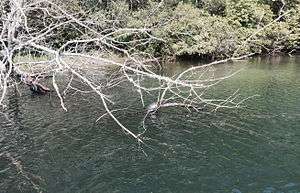Plymouth red-bellied turtle
| Plymouth red-bellied turtle | |
|---|---|
| Scientific classification | |
| Kingdom: | Animalia |
| Phylum: | Chordata |
| Class: | Reptilia |
| Subclass: | Anapsida |
| Order: | Testudines |
| Suborder: | Cryptodira |
| Superfamily: | Testudinoidea |
| Family: | Emydidae |
| Genus: | Pseudemys |
| Species: | P. rubriventris |
| Subspecies: | P. r. bangsi |
| Trinomial name | |
| Pseudemys rubriventris bangsi Babcock, 1937 | |

The Plymouth red-bellied turtle (Pseudemys rubriventris bangsi), sometimes called the Plymouth red-bellied cooter, the first[1] freshwater turtle in the US to be listed as endangered, by the United States Fish and Wildlife Service[2][3] was found only in Plymouth County, Massachusetts before the state began trying to establish populations in other areas. Current thinking is that they are not a full subspecies and that they belong in synonymy under Pseudemys rubriventris or northern red-bellied cooter.[4] Nevertheless, it is well recognized that the Plymouth red-bellied turtle extends the range of the northern red-bellied cooter by 30–40 percent.[3] In 1983, Massasoit National Wildlife Refuge was established to help conserve the Plymouth red-bellied turtle.
This turtle gets its name from its reddish plastron or undershell. They have flattened or slightly concave vertebral scutes with a red bar on each marginal scute. Their upper shell or carapace ranges from brown to black. An arrow-shaped stripe runs atop head, between the eyes, to their snout. Adults are 10–16 inches (25–41 cm). Males have elongated, straight claws on the front feet.[5]
It lives in the Plymouth Pinelands of the Massachusetts and spends most of its time in freshwater ponds. In spring and summer, the females nest in sand while the males look for food. Females lay 5–17 eggs at a time. The incubation of the eggs takes 73 to 80 days, and the eggs hatch at around 25 °C (77 °F). Hatchlings are about 32 millimetres (1.3 in) long. Eggs and young turtles are prey to skunks, raccoons, birds, and fish. Their natural lifespan is 40 to 45 years. The population had been reduced to 200–300 turtles by the 1980s. By 2007, there were estimated to be 400–600 breeding age turtles across 20 ponds. This is due to overhunting by its natural predator the skunk and pollution from herbicides dumped into streams and ponds. Loss of habitat, as a result of filling in ponds to create houses is also a major issue.[3]
References
- ↑ Endangered Species Technical Bulletin Vol 19
- ↑ Endangered and Threatened Wildllfe and Plants; Listing as Endangered With Critical Habitat for the Plymouth Red-Bellied Turtle In Massachusetts Federal Register Vol. 45, No. 65 Wednesday, April 2, 1980
- 1 2 3 "5 Year Review of pseudemys rubiventris northern red-bellied cooter" (PDF). U.S. Fish and Wildlife Service. May 3, 2007. p. 30. Retrieved January 6, 2010.
Retain as endangered but amend listing to identify Plymouth County, Massachusetts population as a distinct population segment.
- ↑ "Pseudemys rubriventris bangsi". Integrated Taxonomic Information System.
- ↑ "Species Profile: Plymouth Red-Bellied Cooter (Pseudemys rubriventris bangsi)". United States Fish and Wildlife Service (public domain). Retrieved January 6, 2010.
External links
- Graham, T.E. Summary report to Mass. Department of Fish and Wildlife, December 31, 1984.

